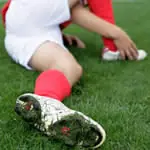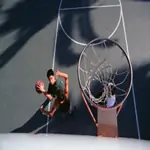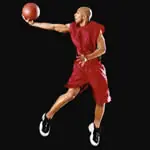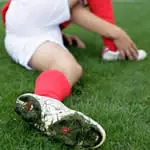Pivoting
The purpose of pivoting is to gain a positional advantage. Learning to pivot in the direction that gives the offensive player positional advantage is an acquired skill. A foot becomes a pivot foot because it is the last foot to touch the floor or the other foot leaves the floor first. Because the pivot foot can turn as long as it remains anchored to the floor, the player is now able to move the other foot without a causing a traveling violation.
Most players keep their entire foot on the floor when pivoting. Most coaches allow this and many teach it. Although commonly used, this not the best bio-mechanical way to place the foot on the floor. If the foot is flat, the player stands straight up instead of being low, balanced and powerful. Remember "heels up." The pivot foot should contact the floor only with the area of the foot directly behind and across all the toes.
A pivot should only be used to gain a positional or tactical advantage like maintaining balance, to get away from the opposing player or to protect the basketball. Once in the ready position following a two-foot jump stop, either foot may be used as the pivot foot. Virtually every basketball movement requires or can be enhanced with proper pivoting.
Plus Sign Pivots -- This is one of the best ways to learn proper pivoting. Find two lines on the court that form perfect 90-degree angles that look a like giant extended (+) plus sign. Place the left pivot foot on the floor at the center of where the lines cross. Then get the body into the ready stance with the heels up. Practice this while holding the basketball in a triple-threat or chin-and-protect position. Be mindful to keep both elbows up to protect not only the ball, but to also help keep defenders from bodying up and crowding the offensive player. Failure to keep the elbows high allows the defender to force the offensive player to step backward and lose balance. That allows the defender to get close enough to swipe the ball away.
Initially, practice just getting into the ready stance with a slightly wider base and establishing balance with the left foot (the pivot foot) on the center of the plus sign. Once comfortable, begin pivoting by moving the right foot and shoulder forward together until they reach the same horizontal line from where the pivot foot (left foot) is anchored.
The most important part of the movement is to keep the pivot foot on the floor while turning on the plus sign. If the foot is not still in the same exact spot when you touch the right foot to the horizontal line, the pivot was done incorrectly. After that, simply reverse the right shoulder and foot back to their original placement. Switch and pivot on the right foot as well to learn and strengthen both legs.
These two movements are commonly referred to as an outside or front pivot and the inside or reverse pivot. Practicing 25 to 50 inside and outside pivots not only teaches great skills development, but is also a great warm-up activity. Practice 100 or more on each foot and it becomes an excellent strength and conditioning activity. Practicing 300 or more can take a player's game to the next level.
Straight Line Pivots -- Learning and executing this pivot is the same as the horizontal + "plus pivot" except for two things. First, the use of the vertical line of the + sign on the floor instead of the horizontal line. Secondly it is also helpful to start holding the basketball under the chin with elbows up. Then position and sweep the ball up over the head or low near the ankles as this protects the basketball from defenders.
This move is highly effective in protecting the basketball when trapped by two defenders. A player utilizing a pivot foot and adding a pass fake becomes very difficult to contain in a trap. This helps players trapped at half court or in a full-court press. Post players and rebounders can also benefit from straight-line pivots and pass fakes to make outlet passes when trapped. Perimeter players use straight line pivots on the perimeter to jab step in attack moves to set up a shot or drive.
Jab Step
The jab step is basically a combination of a pivot and a fake jump-step. First establish a pivot foot. Keeping the heel up on the pivot foot allows a player to have balance, the ability to change the direction before dribbling, and the ability to push off with enough power to maximize quickness of the individual player.
The jab step is used to get defenders to move away or turn in an attempt to stop the offensive player. Players often jab to the left or right, but it is more effective sometimes to jab directly at the spot just outside and past the defender's foot. Experiment to see if the defender has a pattern of putting more effort in turning or moving back more when you jab at their front or back foot, or both equally.
Practice shooting as well as moves that attack both sides. If the defender steps back, the offensive player can return to the original position with momentary clearance in time to get off a good shot. If the defender turns to cut off the angle of the jab step, the offensive player goes opposite, often attacking the front foot of the defender to gain a positional advantage to drive past the defender.
It is very important to actually be trying to beat the defender by exploding into a first step. This move should be done only if you read the defender and realize that you have not created a positional advantage.
Crossover Step
Starting from a low-ready position, protecting the ball in a chin, low sweep or rip through, pivot in the direction you want to travel while simultaneously bringing the opposite shoulder, hip and foot across the body and in the same direction. To maximize the effect of this move, push off the pivot foot like a sprinter using a jump step and raising the opposite knee high to increase explosiveness. This move is highly effective without any fakes, especially if you can lull the defender into being still and flat-footed. It becomes a race, and the offensive player gets to say go. If playing against a quicker or active defender, use the jab step first to help set up your attack.
The crossover can also be used without the basketball to cut off the offensive player on defense and to gain box-out position as a rebounder. Combining the ready position, crossover, jump step and two-foot jump-stop is a highly effective and disruptive use of proper defensive footwork.
Drop Step
This move can be used to counter an aggressive defender over-playing one side of the offensive player--who is trying to recieve a pass or gain a positional advantage to drive or shoot when they already have the basketball. The drop step, like the crossover step, can also be utilized by rebounders to gain and maintain a positional advantage. The move is essentially a reverse pivot where the player uses their leg and hip to block and hold off the opposing player.
Commonly used on offense in back-to-the-basket post moves, it is equally effective by perimeter players who are being overplayed. First, make sure to use the two-foot jump stop to help ensure catching the basketball. As the catch is made, determine where the opposing player is coming from and prepare to land with a two-foot jump stop and immediately start a reverse pivot, leg sweep towards the basket utilizing the hip to both seal off and push the defender away.
- 2
- of
- 3







Discuss This Article